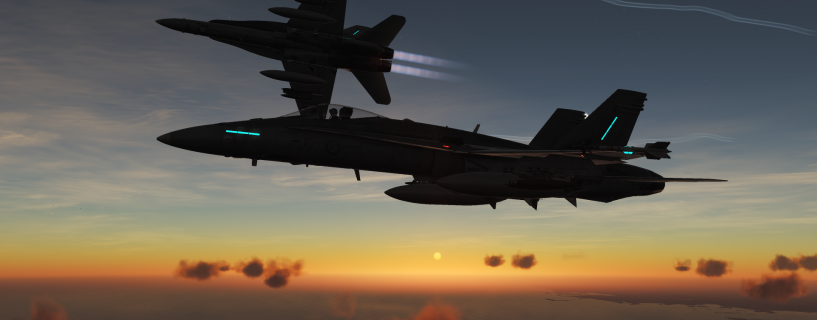
Tactical Form Positions
The Formations and the Theory!
Formation why fly it?
We fly formation because:
- Mutual Support and Cover.
- Additional Weapons on target.
- Higher Life Expectancy.
This means that people need to:
- Trust Lead to do his job.
- Be in position.
- Not be a lone wolf. (Check the ego at the door).
The most basic Formation an Element, an Element consists of 2 aircraft.
Lead – the guy in charge of the Element, keeping it going were its meant to be going.
Wing – The guy flying on Leads wing, his job is to be there and act as an extension of Leads will. He’s an extra set of eyes, extra weapons and a extra set of sensors.
The Formations
Parade Formation.
While it looks cool, Parade isn’t flown often in combat!
Wing flies about 45 and slightly in trail on lead it is a Tight formation, doesn’t allow for rapid moves by both aircraft. Both AC are typically within .1-2 nm of each other.
Echelon Formation.
Echelon Formation almost the same as parade, except that the distance between Lead and Wing is far more dynamic. Can be ‘Close’ or ‘Loose’ also refereed to as ‘Close’ or ‘Far’ etc.
Close is .25-.5nm
Loose is .5 – 1.5nm
We don’t use this formation a lot at TGW because we prefer to use Combat Spread.
Spread/Combat Spread
Combat spread is also known as ‘Line Abreast’ it is flown typically at Co Altitude -1,000 to +1,000 with 0.75 – 1.2nm spacing. Combat spread allows for mutual support and easy formation moving as well as giving room for defensive/offensive manoeuvring it also helps lead judge the distances for weapons release far quicker as all weapons are at the exact same range.
A Flight, 2 Elements.
A flight consists of 2 elements.
Formations in a flight are the same just larger, when in a flight Element 2 is Callsign 3 & 4, but follow the Flight Leads orders unless split from the group.When they split out from the Group 3 becomes the flight lead for the second Element. Normally you try and have your most experienced formation lead in the 1 position and the second most in the 3 position.
Tactical Form Turns
How to get from a to b and keep together.
In-Place Turn
In place turns are used to turn 180 degrees and keep formation geometry except mirrored always is a 3g Turn the steps for conducting a in place turn are as follows:
Executed with ‘In Place, Left/Right’
- Lead will call “In Place, Left/Right” and any execute command. Often in combat there is no execute command given.
- All Airframes pull a 3g turn in the direction called, and maintain until they are 180 degrees of their original course. At the 90 mark you should see the other plane in front.
- Both jets roll out mirrored geometry on a 180 heading to previous.
Cross Turn
A cross turn is used to turn 180 Degree’s while keeping the formation geometry in the same position. It can also be used for allowing quick and rapid clearing of a wing or leads tail.
- Starting in spread, lead will call “Cross” along with their execute command.
- Both jets do a 3g turn towards each other, Lead will go High to avoid collision.
- Both jets should come out 180 to their base course.
Delay Turn
Used for turns 45 degree’s or more but less then 180 it maintains formation Geometry, but mirrors it. Can be used to fix geometry issues if required as well by adjusting the timing on the turns, it is always a 4G turn.
Executed with Delay, Direction, Heading. Eg Delay Left 070.
- The outmost aircraft begins a 4g turn towards the heading. Inner most continues on current heading.
- When the outside aircraft aspect begins to cross the tail inside begins a 4g turn.
- Both Aircraft roll out on heading.
Shackle
A shackle is used to maintain same direction of flight but reposition a flight member within the formation. It is used for clearing, changing position for weapon employment etc, it can also be used to fix spacing issues.
A shackle is excuted with ‘Flightname, Shackle’ eg Magpies Shackle.
- Both Aircraft begin a 4 g turn towards each other. Lead will go HIGH.
- Both Aircraft cross each other and reverse their 4g turn, back onto the original heading
- Both Aircraft Roll out.






Very satisfying when it’s pulled off in combat 🙂